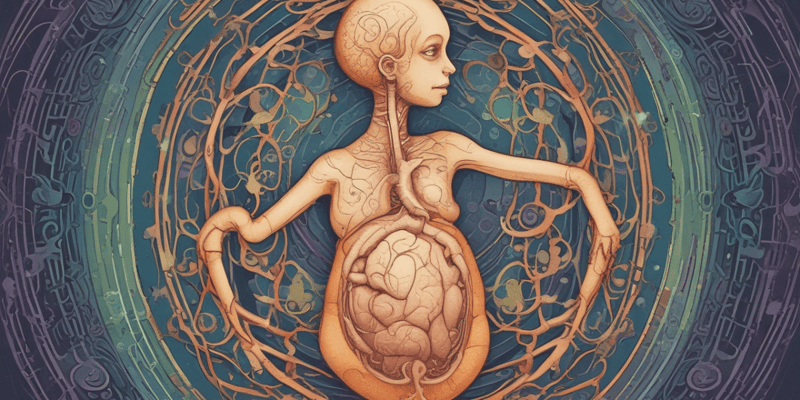31 Questions
What is the typical location where a sperm fertilizes an egg?
Distal one-third of the uterine tube
During which process do the organs and organ systems develop from the germ layers?
Organogenesis
What is the term for the degeneration of an organ system that occurs with aging?
Senescence
What is the term for an individual from the beginning of the ninth week through birth?
Fetus
How many cells does the conceptus consist of by the time it arrives in the uterus?
16 or more
What bypasses the liver and what bypasses the lungs in fetal circulation?
Ductus venosus; ductus arteriosus
In which part of the uterine tube does fertilization typically occur?
Distal one-third
What is the primary function of the placenta during fetal development?
Excretory, nutritional, endocrine, and immune functions
During which stage of development do the germ layers differentiate into organs and organ systems?
Organogenesis
What is the term for an individual from the sixteenth day of gestation to the eighth week?
Embryo
How long does the normal gestation period for a single baby typically last?
40 weeks
What is the optimal time frame for conceiving a child?
A few days before ovulation to less than a day after
What structures in fetal circulation bypass the liver and lungs, respectively?
Ductus venosus; ductus arteriosus
Which of the following is not a derivative of ectoderm?
Dermis
What is the term for the stage of development when the individual's organ systems are fully present?
Fetal stage
Which of the following major events of prenatal development occurs first?
The central nervous system begins to form
What is the primary function of the placenta during fetal development?
Exchanging oxygen and nutrients for waste products
During which stage of development do the germ layers differentiate into tissues?
Organogenesis
What is the significance of the ninth week of gestation in fetal development?
The embryo is now referred to as a fetus
What is the approximate number of cells present in the conceptus when it arrives in the uterus?
16-20 cells
Which of the following is not a function of the placenta?
Mechanical support
What is the term for the stage of development from the sixteenth day of gestation to the eighth week?
Embryo
What is the optimal time frame for conception?
A few days before ovulation to less than a day after ovulation
What is the term for an individual from birth to 6 weeks old?
Neonate
Which of the following is a characteristic of the normal gestation period for a single baby?
It lasts approximately 40 weeks
What is the primary direction of nutrient and waste exchange in the placenta?
Oxygen and nutrients from the maternal blood to the fetal blood, and wastes from the fetal blood to the maternal blood
What is the main function of the structure that develops from the germ layers between the 16th day of gestation and the 8th week?
Embryogenesis
At what stage of development does the conceptus consist of at least 16 or more cells?
When it arrives in the uterus
What is the primary direction of exchange between the maternal and fetal blood in the placenta?
Oxygen and nutrients from the maternal blood to the fetal blood
What is the significance of the 9th week of gestation in fetal development?
It marks the end of the embryonic stage.
What is the optimal time frame for conceiving a child?
A few days before ovulation to less than a day after
Study Notes
Fertilization
- Sperm generally fertilizes an egg in the distal one-third of the uterine tube.
Fetal Development
- The structure that performs excretory, nutritional, endocrine, and immune functions for the fetus is the placenta.
- During development, an individual is known as a fetus from the beginning of the ninth week through birth.
- A developing individual from the sixteenth day of gestation is referred to as an embryo.
- The normal gestation period for a single (non-twin) baby is 40 weeks.
- An infant up to 6 weeks old is called a neonate.
Prenatal Development
- The process in which the germ layers differentiate into organs and organ systems is called organogenesis.
- By the end of 8 weeks, the individual is considered a fetus because all of the organ systems are present.
- The central nervous system begins to form first in prenatal development.
- In fetal circulation, the ductus venosus bypasses the liver and the ductus arteriosus bypasses the lungs.
Developmental Stages
- The optimal "window of opportunity" to conceive a child is a few days before ovulation to less than a day after.
- By the time the conceptus arrives in the uterus, it consists of at least 16 or more cells.
Cellular Development
- Oxygen and nutrients pass from the maternal blood to the fetal blood, while wastes pass the other way.
Embryonic Membranes
- The placenta is not considered an embryonic membrane.
- Dermis is not a derivative of ectoderm.
Aging
- Senescence is the degeneration in an organ system that occurs with aging.
Test your knowledge of human development, from fertilization to birth, and explore the fascinating world of fetal development. Learn about the crucial stages of growth and development, and how the fetus grows and matures. Discover the wonders of human biology!
Make Your Own Quizzes and Flashcards
Convert your notes into interactive study material.
Get started for free



